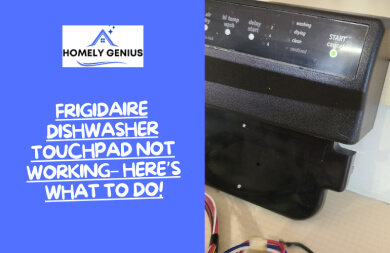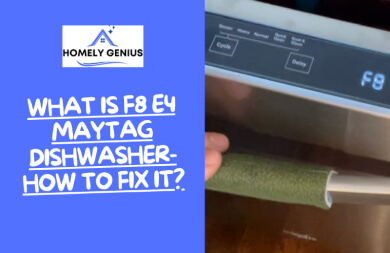Kenmore Dishwasher Not Drying! Troubleshooting And Fixes

Kenmore dishwashers are known for their cleaning features, including PowerWash, MicroClean, TurboZone, and SmartDry. Besides, they are energy-efficient and quiet. Still, users often complain that their Kenmore dishwasher not drying.
This issue usually occurs because of faulty heating elements, malfunctioning vent systems, faulty high-limit thermostats, insufficient rinse aids, faulty control boards, etc. Though it seems that these are very complex and difficult to fix, it is not.
In most cases, you can fix this problem yourself with a little bit of money. So let’s jump into its troubleshooting and fixing procedures.
Troubleshooting And Fixes Of Kenmore Dishwasher Not Drying Issue
Kenmore dishwashers use a combination of methods to dry dishes. Here a heating element inside the dishwasher warms the air inside and a fan circulates this warm air around the dishes.
Next, a vent at the top of the dishwasher releases steam and humidity produced during the drying process. But, when any of these parts malfunctions, dishes don’t dry completely.
Here are some troubleshooting and fixing steps to solve the Kenmore dishwasher not drying issue.
1. Insufficient rinse aid (Make sure there are enough rinse aid)
Rinse aid helps to prevent water from beading up on the surface of dishes, which helps them to dry faster and evenly. But if the rinse aid dispenser is empty or low, the dishes will not dry properly.
To check the rinse aid level, look for the rinse aid dispenser located inside the door (next to the detergent compartment). If it’s empty or its quantity/level is too low, refill it. This may cost around $5 to $20.
2. Faulty vent assembly (Check and ensure it’s working perfectly)
The vent is responsible for releasing the hot, steamy air generated during the rinse cycle. But when the vent gets blocked or the vent fan motor malfunctions, moist air can’t get out and makes the dishes wet.
In this situation, fully open the vent assembly and check the vent for any blockages. This could be food particles, grease, or other debris. If you find any blockages, remove them using a toothpick or other small object.
But if its condition looks worse, like something inside is broken, you need to replace it. Depending on the model and quality, this may cost around $10 to $50.
If the vent looks fine, then check the fan and motor to know if it’s working perfectly. Here try to rotate the fan blades or wheel and if it rotates freely then it’s okay.
But if it doesn’t rotate freely, then it’s likely the motor bearings have seized. In that case, you have to replace the motor.
Additionally, if you want to be sure this motor is really damaged, you can test it with a multimeter.
Here is a short video on how to do it:
Now if you find that the motor is damaged then you need to replace it as soon as possible. This could cost you between $80 and $140.
3. Faulty heating element (Check and if needed replace it)
If the vent section works fine, but the issue is not solved, then maybe the heating element isn’t working properly.
The heating element is typically located at the bottom of the dishwasher tub. When an electrical current is passed through this, it heats up and transfers heat to the surrounding water or air.
However, faulty heating elements may not evenly heat the air, or if they do, they may not be enough to dry the dishes.
In this situation, at first, visually inspect the heating element to find any damage or cracks. If you notice any, then replace it. But if it looks perfect, then check if it is working properly or not.
To do it, after washing the dishes, open the dishwasher lid and drop a few drops of water on it. If the water vapors immediately, it means that the heating element is fine.
But, because of a faulty control board, the heating element mightn’t get enough power to work. So, in this case, check the heating element individually. Finally, if it is really damaged then you need to change it. This may cost you around $25 to $40.
Follow this short video to do it:
4. Faulty high-limit thermostat (Check and if needed replace it)
If the issue still exists, then there’s a possibility that the high-limit thermostat isn’t working properly.
The high-limit thermostat is a safety device that prevents the dishwasher from overheating. If it malfunctions, it can shut off the heating element prematurely. As a result, dishes won’t dry effectively.
To test the high-limit thermostat, first remove/disassemble it from the dishwasher. Now take a multimeter and set it on Continuity Mode. Then touch multimeter probes to each terminal of the thermostat and test it for continuity.
If the multimeter shows zero ohms, the thermostat is good. But if the multimeter doesn’t show any readings (analog multimeter) or the readings don’t change significantly (digital multimeter), means there is no Continuity and it’s faulty.
**N.B: A good thermostat shows continuity at a room temperature of 68 °F. But when it is heated (250 °F – 300 °F) you won’t get any continuity.
So, check it again at 250 °F – 300 °F. If it’s found faulty, you have to replace it. This may cost around $8 to $20.
5. Damaged control board (Inspect and repair or replace it as required)
After following all the above-mentioned solutions, if the issue still exists, then it means that the main control panel is damaged.
In a dishwasher, a control board controls all the functions and electrical equipment. But when it becomes faulty, it doesn’t respond to your commands and can’t supply power to the necessary equipment including the heating element.
In this situation, it’s better to replace the whole control panel unit, instead of repairing it. But if you are on a low budget, then you can try repairing it. So you have to call a mechanic for the required solution.
Here, replacing a control board with a new one might cost around $90 to $200.
Tips To Prevent Kenmore Dishwasher Dishes Not Drying Issue
Like any electrical appliance, a dishwasher that is not properly maintained can wear out more quickly. However, following a few tips will save you time and money in the long run, and your dishwasher will last for a long time.
- Use the correct amount of detergent
- Always keep the heating element clean
- Use the proper amount of rinse aid
- Don’t overload the dishwasher
- Ensure proper water temperature
- Clean the filters regularly
FAQs
After reading this article till now, if you still have some questions in your mind which aren’t answered yet, check out this FAQ section. Hopefully, you will get the answers to your questions.
Can I Fix This Issue Myself, Or I Have To Take An Expert Help?
Typically you can fix any minor issues. Such as: adding a rinse aid, cleaning the vent, replacing the heating element, changing the high-temp thermostat, etc. But for any serious causes, it’s wise to get help from a mechanic.
Do Kenmore Dishwasher Warranty Cover Dishes Not Drying Issues?
Depending on the cycle selected, a Kenmore dishwasher usually takes about 1 to 3 hours to clean and dry the dishes. Here the shortest cycle is typically the Quick Wash cycle, which takes about 1 hour.
How Long Does It Take To Solve This Issue?
Basically, the time required to fix this issue totally depends on the causes. Here fixing a minor issue requires 15 to 30 minutes but a major problem may require several hours or days.
Final Words
Hopefully you solved your Kenmore dishwasher not drying issue. Here remember that not only Kenmore, all the dishwashers are extremely sophisticated electronic appliances with many delicate parts.
So it is inevitable that at some point you will run into some difficulties. In this situation, just figure out why it’s happening and fix it. If you can’t do it yourself, ask someone who knows.




![How to Find GE Dishwasher Fuse Location [2023]](https://homelygenius.com/wp-content/uploads/2023/10/ge-dishwasher-fuse-location.jpg)

